Globalisation Factors: A Business Logistics Evaluation (2019/2020)
VerifiedAdded on 2023/01/17
|8
|2537
|21
Report
AI Summary
This report provides a comprehensive analysis of key factors impacting organizations operating in the global business landscape, specifically focusing on the years 2019/2020 and beyond. It begins with an introduction to business logistics and globalization, emphasizing the interconnectedness of economies and the drivers of globalization, including market, cost, government, and competitive factors. The main body critically evaluates these factors, exploring market drivers such as customer behavior and distribution channels, cost drivers like economies of scale, and government influences on trade policies and technical standards. The report also examines the impact of globalization on labor sectors, economic development, and strategic shifts within organizations. It discusses various STEEPLE factors, including economic considerations like raw material costs, storage and transportation costs, and labor skills. Furthermore, the report delves into global strategies, including market participation, product standardization, and uniform marketing approaches. It also addresses challenges like cultural differences, financial risks, and the adoption of adaptive strategies. The conclusion summarizes the importance of globalization for business success and highlights the different drivers that lead to globalization.
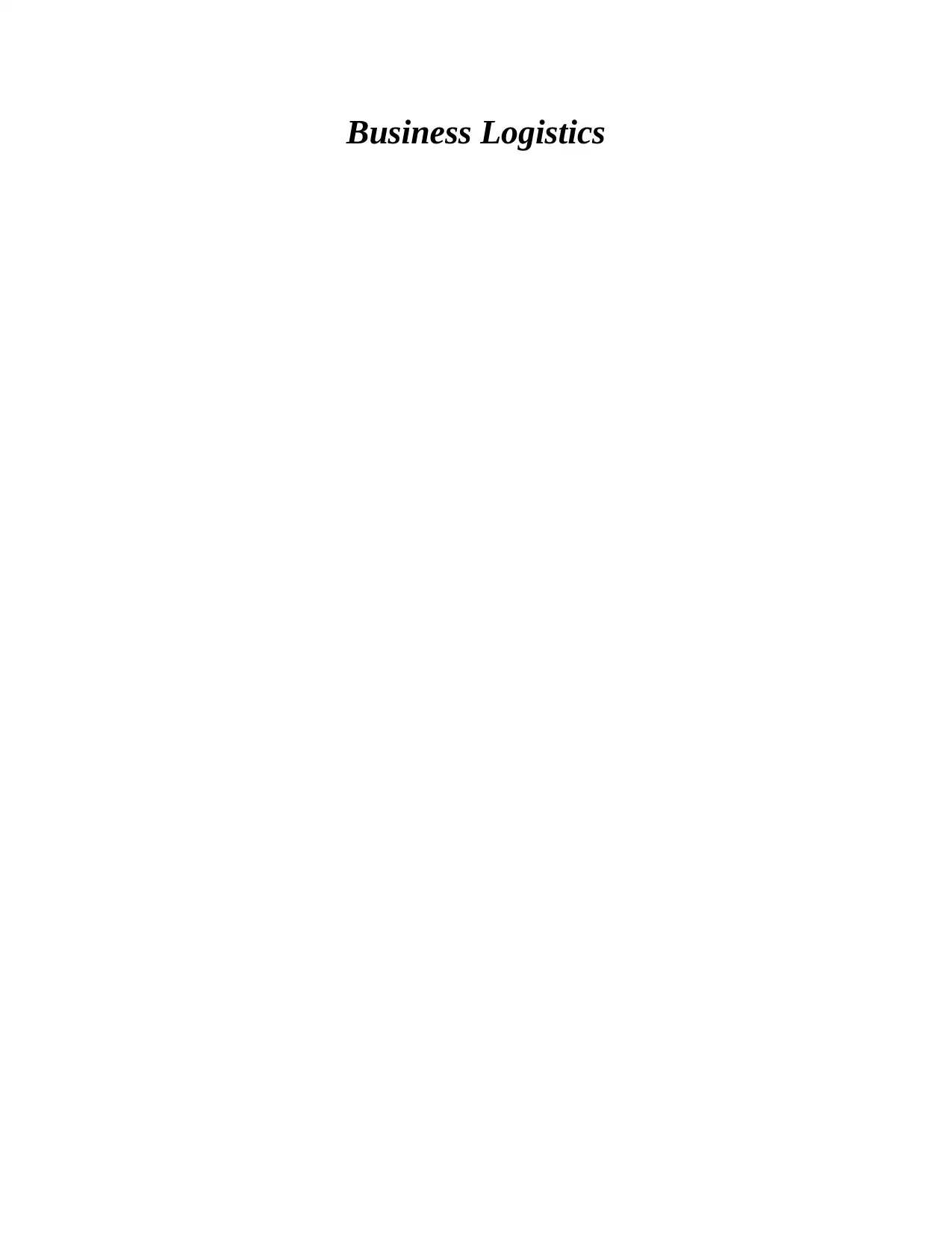
Business Logistics
Paraphrase This Document
Need a fresh take? Get an instant paraphrase of this document with our AI Paraphraser
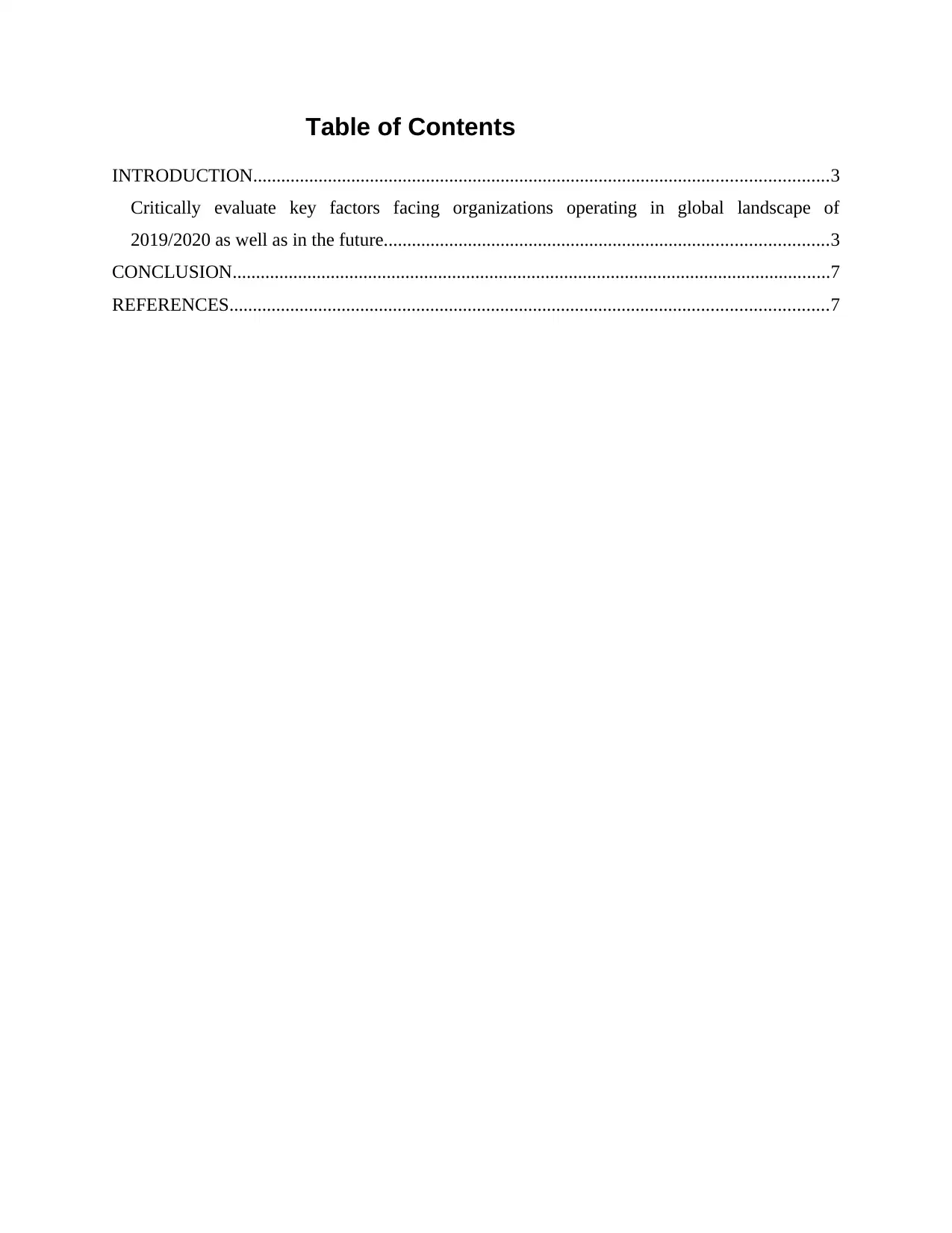
Table of Contents
INTRODUCTION...........................................................................................................................3
Critically evaluate key factors facing organizations operating in global landscape of
2019/2020 as well as in the future...............................................................................................3
CONCLUSION................................................................................................................................7
REFERENCES................................................................................................................................7
INTRODUCTION...........................................................................................................................3
Critically evaluate key factors facing organizations operating in global landscape of
2019/2020 as well as in the future...............................................................................................3
CONCLUSION................................................................................................................................7
REFERENCES................................................................................................................................7
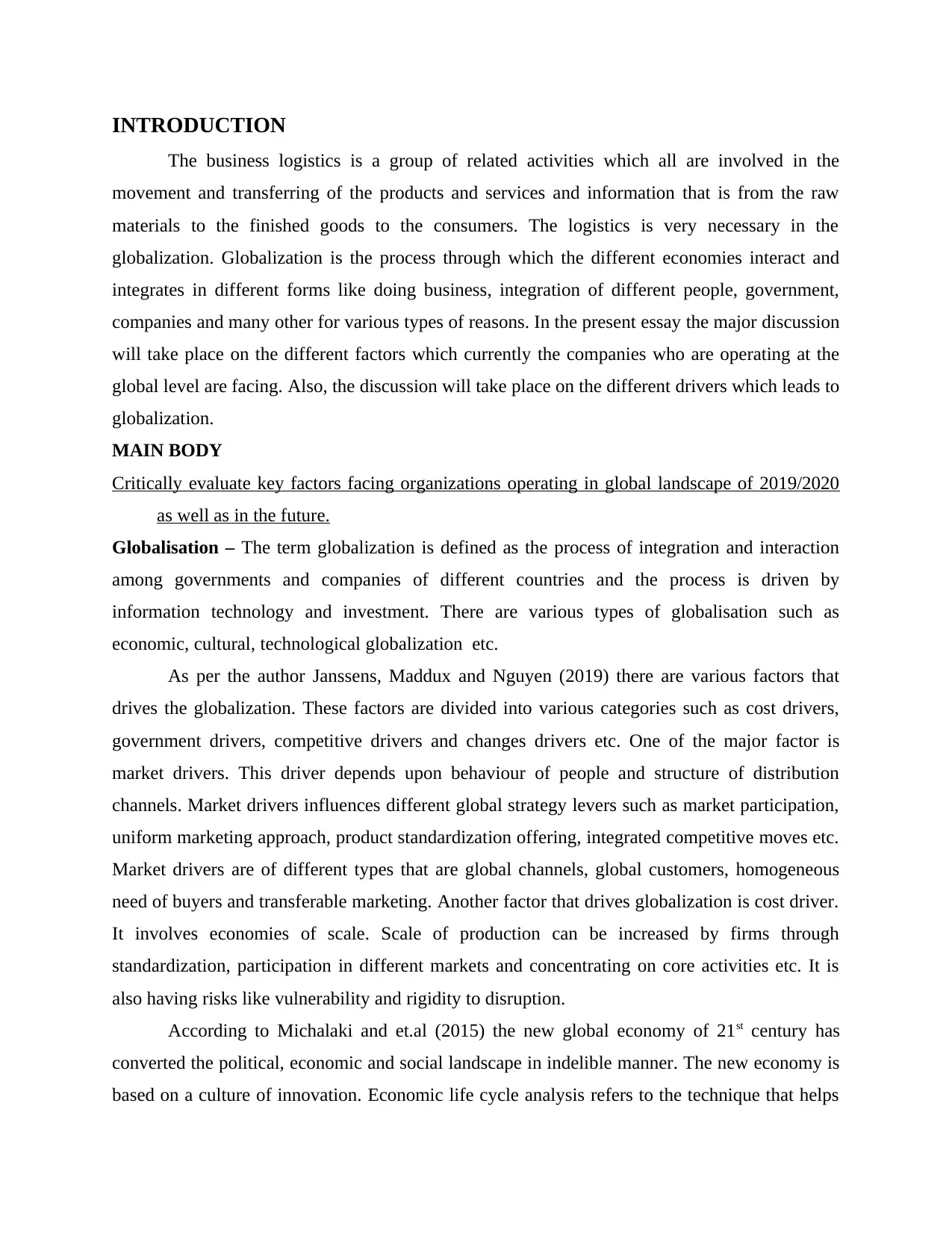
INTRODUCTION
The business logistics is a group of related activities which all are involved in the
movement and transferring of the products and services and information that is from the raw
materials to the finished goods to the consumers. The logistics is very necessary in the
globalization. Globalization is the process through which the different economies interact and
integrates in different forms like doing business, integration of different people, government,
companies and many other for various types of reasons. In the present essay the major discussion
will take place on the different factors which currently the companies who are operating at the
global level are facing. Also, the discussion will take place on the different drivers which leads to
globalization.
MAIN BODY
Critically evaluate key factors facing organizations operating in global landscape of 2019/2020
as well as in the future.
Globalisation – The term globalization is defined as the process of integration and interaction
among governments and companies of different countries and the process is driven by
information technology and investment. There are various types of globalisation such as
economic, cultural, technological globalization etc.
As per the author Janssens, Maddux and Nguyen (2019) there are various factors that
drives the globalization. These factors are divided into various categories such as cost drivers,
government drivers, competitive drivers and changes drivers etc. One of the major factor is
market drivers. This driver depends upon behaviour of people and structure of distribution
channels. Market drivers influences different global strategy levers such as market participation,
uniform marketing approach, product standardization offering, integrated competitive moves etc.
Market drivers are of different types that are global channels, global customers, homogeneous
need of buyers and transferable marketing. Another factor that drives globalization is cost driver.
It involves economies of scale. Scale of production can be increased by firms through
standardization, participation in different markets and concentrating on core activities etc. It is
also having risks like vulnerability and rigidity to disruption.
According to Michalaki and et.al (2015) the new global economy of 21st century has
converted the political, economic and social landscape in indelible manner. The new economy is
based on a culture of innovation. Economic life cycle analysis refers to the technique that helps
The business logistics is a group of related activities which all are involved in the
movement and transferring of the products and services and information that is from the raw
materials to the finished goods to the consumers. The logistics is very necessary in the
globalization. Globalization is the process through which the different economies interact and
integrates in different forms like doing business, integration of different people, government,
companies and many other for various types of reasons. In the present essay the major discussion
will take place on the different factors which currently the companies who are operating at the
global level are facing. Also, the discussion will take place on the different drivers which leads to
globalization.
MAIN BODY
Critically evaluate key factors facing organizations operating in global landscape of 2019/2020
as well as in the future.
Globalisation – The term globalization is defined as the process of integration and interaction
among governments and companies of different countries and the process is driven by
information technology and investment. There are various types of globalisation such as
economic, cultural, technological globalization etc.
As per the author Janssens, Maddux and Nguyen (2019) there are various factors that
drives the globalization. These factors are divided into various categories such as cost drivers,
government drivers, competitive drivers and changes drivers etc. One of the major factor is
market drivers. This driver depends upon behaviour of people and structure of distribution
channels. Market drivers influences different global strategy levers such as market participation,
uniform marketing approach, product standardization offering, integrated competitive moves etc.
Market drivers are of different types that are global channels, global customers, homogeneous
need of buyers and transferable marketing. Another factor that drives globalization is cost driver.
It involves economies of scale. Scale of production can be increased by firms through
standardization, participation in different markets and concentrating on core activities etc. It is
also having risks like vulnerability and rigidity to disruption.
According to Michalaki and et.al (2015) the new global economy of 21st century has
converted the political, economic and social landscape in indelible manner. The new economy is
based on a culture of innovation. Economic life cycle analysis refers to the technique that helps
⊘ This is a preview!⊘
Do you want full access?
Subscribe today to unlock all pages.

Trusted by 1+ million students worldwide
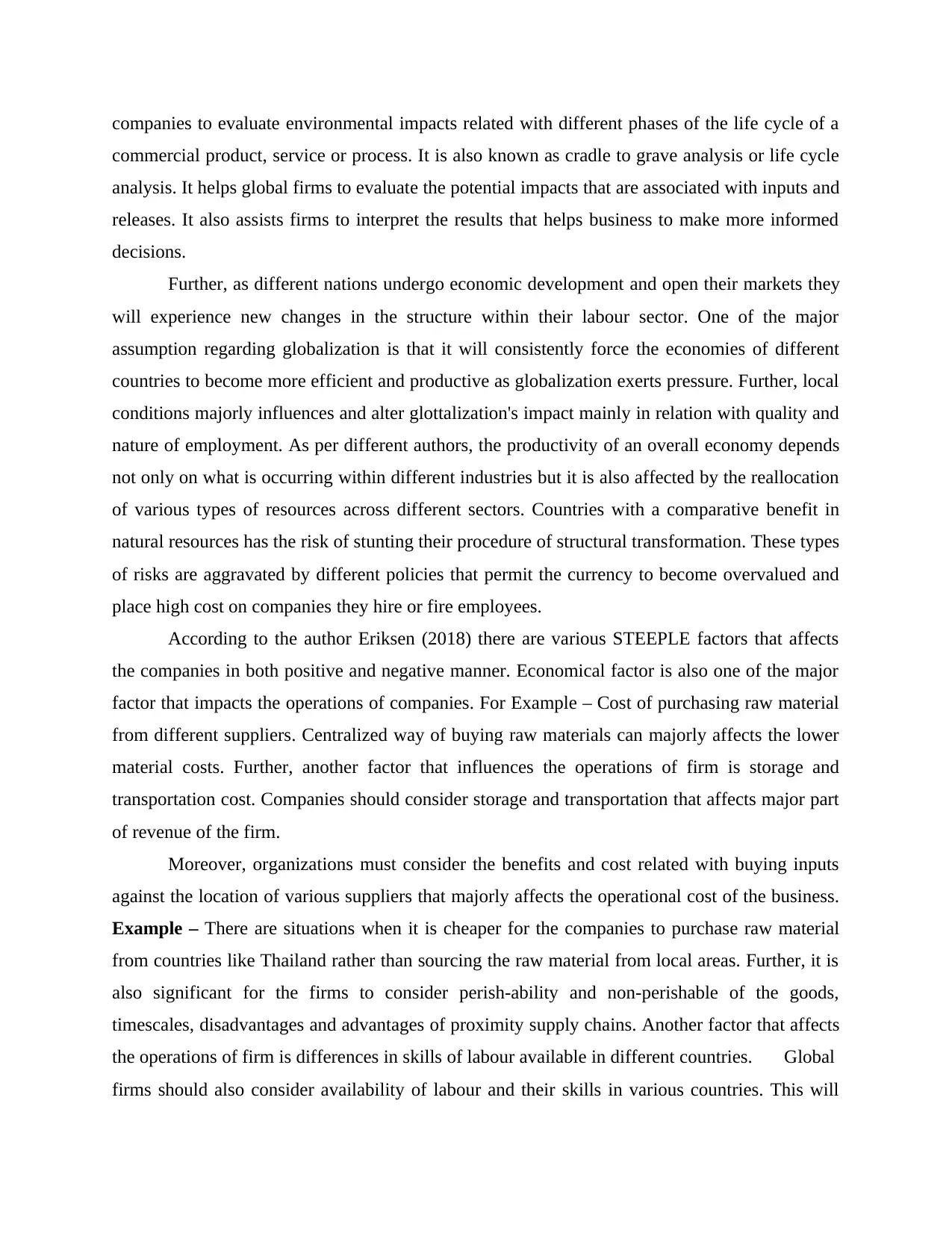
companies to evaluate environmental impacts related with different phases of the life cycle of a
commercial product, service or process. It is also known as cradle to grave analysis or life cycle
analysis. It helps global firms to evaluate the potential impacts that are associated with inputs and
releases. It also assists firms to interpret the results that helps business to make more informed
decisions.
Further, as different nations undergo economic development and open their markets they
will experience new changes in the structure within their labour sector. One of the major
assumption regarding globalization is that it will consistently force the economies of different
countries to become more efficient and productive as globalization exerts pressure. Further, local
conditions majorly influences and alter glottalization's impact mainly in relation with quality and
nature of employment. As per different authors, the productivity of an overall economy depends
not only on what is occurring within different industries but it is also affected by the reallocation
of various types of resources across different sectors. Countries with a comparative benefit in
natural resources has the risk of stunting their procedure of structural transformation. These types
of risks are aggravated by different policies that permit the currency to become overvalued and
place high cost on companies they hire or fire employees.
According to the author Eriksen (2018) there are various STEEPLE factors that affects
the companies in both positive and negative manner. Economical factor is also one of the major
factor that impacts the operations of companies. For Example – Cost of purchasing raw material
from different suppliers. Centralized way of buying raw materials can majorly affects the lower
material costs. Further, another factor that influences the operations of firm is storage and
transportation cost. Companies should consider storage and transportation that affects major part
of revenue of the firm.
Moreover, organizations must consider the benefits and cost related with buying inputs
against the location of various suppliers that majorly affects the operational cost of the business.
Example – There are situations when it is cheaper for the companies to purchase raw material
from countries like Thailand rather than sourcing the raw material from local areas. Further, it is
also significant for the firms to consider perish-ability and non-perishable of the goods,
timescales, disadvantages and advantages of proximity supply chains. Another factor that affects
the operations of firm is differences in skills of labour available in different countries. Global
firms should also consider availability of labour and their skills in various countries. This will
commercial product, service or process. It is also known as cradle to grave analysis or life cycle
analysis. It helps global firms to evaluate the potential impacts that are associated with inputs and
releases. It also assists firms to interpret the results that helps business to make more informed
decisions.
Further, as different nations undergo economic development and open their markets they
will experience new changes in the structure within their labour sector. One of the major
assumption regarding globalization is that it will consistently force the economies of different
countries to become more efficient and productive as globalization exerts pressure. Further, local
conditions majorly influences and alter glottalization's impact mainly in relation with quality and
nature of employment. As per different authors, the productivity of an overall economy depends
not only on what is occurring within different industries but it is also affected by the reallocation
of various types of resources across different sectors. Countries with a comparative benefit in
natural resources has the risk of stunting their procedure of structural transformation. These types
of risks are aggravated by different policies that permit the currency to become overvalued and
place high cost on companies they hire or fire employees.
According to the author Eriksen (2018) there are various STEEPLE factors that affects
the companies in both positive and negative manner. Economical factor is also one of the major
factor that impacts the operations of companies. For Example – Cost of purchasing raw material
from different suppliers. Centralized way of buying raw materials can majorly affects the lower
material costs. Further, another factor that influences the operations of firm is storage and
transportation cost. Companies should consider storage and transportation that affects major part
of revenue of the firm.
Moreover, organizations must consider the benefits and cost related with buying inputs
against the location of various suppliers that majorly affects the operational cost of the business.
Example – There are situations when it is cheaper for the companies to purchase raw material
from countries like Thailand rather than sourcing the raw material from local areas. Further, it is
also significant for the firms to consider perish-ability and non-perishable of the goods,
timescales, disadvantages and advantages of proximity supply chains. Another factor that affects
the operations of firm is differences in skills of labour available in different countries. Global
firms should also consider availability of labour and their skills in various countries. This will
Paraphrase This Document
Need a fresh take? Get an instant paraphrase of this document with our AI Paraphraser
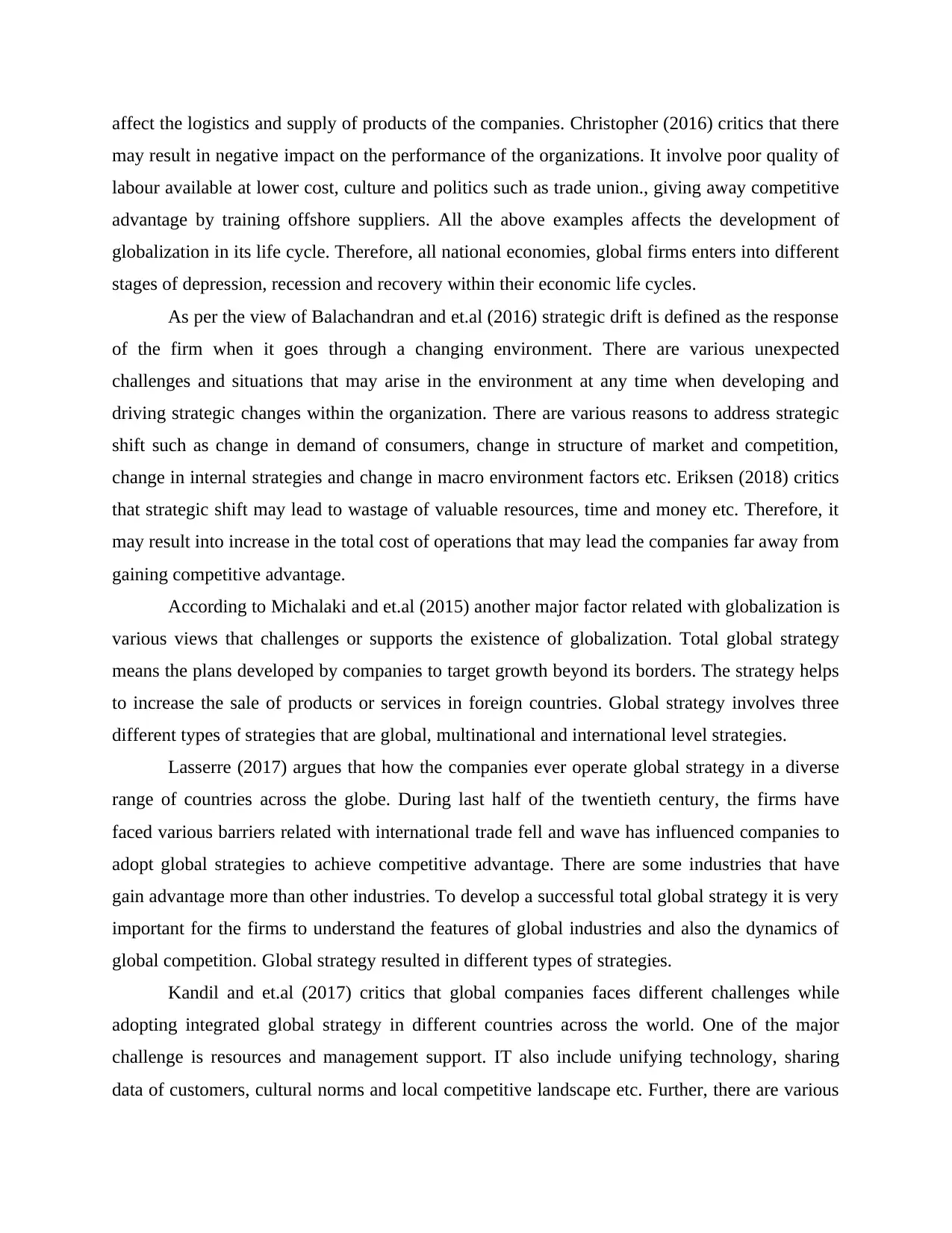
affect the logistics and supply of products of the companies. Christopher (2016) critics that there
may result in negative impact on the performance of the organizations. It involve poor quality of
labour available at lower cost, culture and politics such as trade union., giving away competitive
advantage by training offshore suppliers. All the above examples affects the development of
globalization in its life cycle. Therefore, all national economies, global firms enters into different
stages of depression, recession and recovery within their economic life cycles.
As per the view of Balachandran and et.al (2016) strategic drift is defined as the response
of the firm when it goes through a changing environment. There are various unexpected
challenges and situations that may arise in the environment at any time when developing and
driving strategic changes within the organization. There are various reasons to address strategic
shift such as change in demand of consumers, change in structure of market and competition,
change in internal strategies and change in macro environment factors etc. Eriksen (2018) critics
that strategic shift may lead to wastage of valuable resources, time and money etc. Therefore, it
may result into increase in the total cost of operations that may lead the companies far away from
gaining competitive advantage.
According to Michalaki and et.al (2015) another major factor related with globalization is
various views that challenges or supports the existence of globalization. Total global strategy
means the plans developed by companies to target growth beyond its borders. The strategy helps
to increase the sale of products or services in foreign countries. Global strategy involves three
different types of strategies that are global, multinational and international level strategies.
Lasserre (2017) argues that how the companies ever operate global strategy in a diverse
range of countries across the globe. During last half of the twentieth century, the firms have
faced various barriers related with international trade fell and wave has influenced companies to
adopt global strategies to achieve competitive advantage. There are some industries that have
gain advantage more than other industries. To develop a successful total global strategy it is very
important for the firms to understand the features of global industries and also the dynamics of
global competition. Global strategy resulted in different types of strategies.
Kandil and et.al (2017) critics that global companies faces different challenges while
adopting integrated global strategy in different countries across the world. One of the major
challenge is resources and management support. IT also include unifying technology, sharing
data of customers, cultural norms and local competitive landscape etc. Further, there are various
may result in negative impact on the performance of the organizations. It involve poor quality of
labour available at lower cost, culture and politics such as trade union., giving away competitive
advantage by training offshore suppliers. All the above examples affects the development of
globalization in its life cycle. Therefore, all national economies, global firms enters into different
stages of depression, recession and recovery within their economic life cycles.
As per the view of Balachandran and et.al (2016) strategic drift is defined as the response
of the firm when it goes through a changing environment. There are various unexpected
challenges and situations that may arise in the environment at any time when developing and
driving strategic changes within the organization. There are various reasons to address strategic
shift such as change in demand of consumers, change in structure of market and competition,
change in internal strategies and change in macro environment factors etc. Eriksen (2018) critics
that strategic shift may lead to wastage of valuable resources, time and money etc. Therefore, it
may result into increase in the total cost of operations that may lead the companies far away from
gaining competitive advantage.
According to Michalaki and et.al (2015) another major factor related with globalization is
various views that challenges or supports the existence of globalization. Total global strategy
means the plans developed by companies to target growth beyond its borders. The strategy helps
to increase the sale of products or services in foreign countries. Global strategy involves three
different types of strategies that are global, multinational and international level strategies.
Lasserre (2017) argues that how the companies ever operate global strategy in a diverse
range of countries across the globe. During last half of the twentieth century, the firms have
faced various barriers related with international trade fell and wave has influenced companies to
adopt global strategies to achieve competitive advantage. There are some industries that have
gain advantage more than other industries. To develop a successful total global strategy it is very
important for the firms to understand the features of global industries and also the dynamics of
global competition. Global strategy resulted in different types of strategies.
Kandil and et.al (2017) critics that global companies faces different challenges while
adopting integrated global strategy in different countries across the world. One of the major
challenge is resources and management support. IT also include unifying technology, sharing
data of customers, cultural norms and local competitive landscape etc. Further, there are various
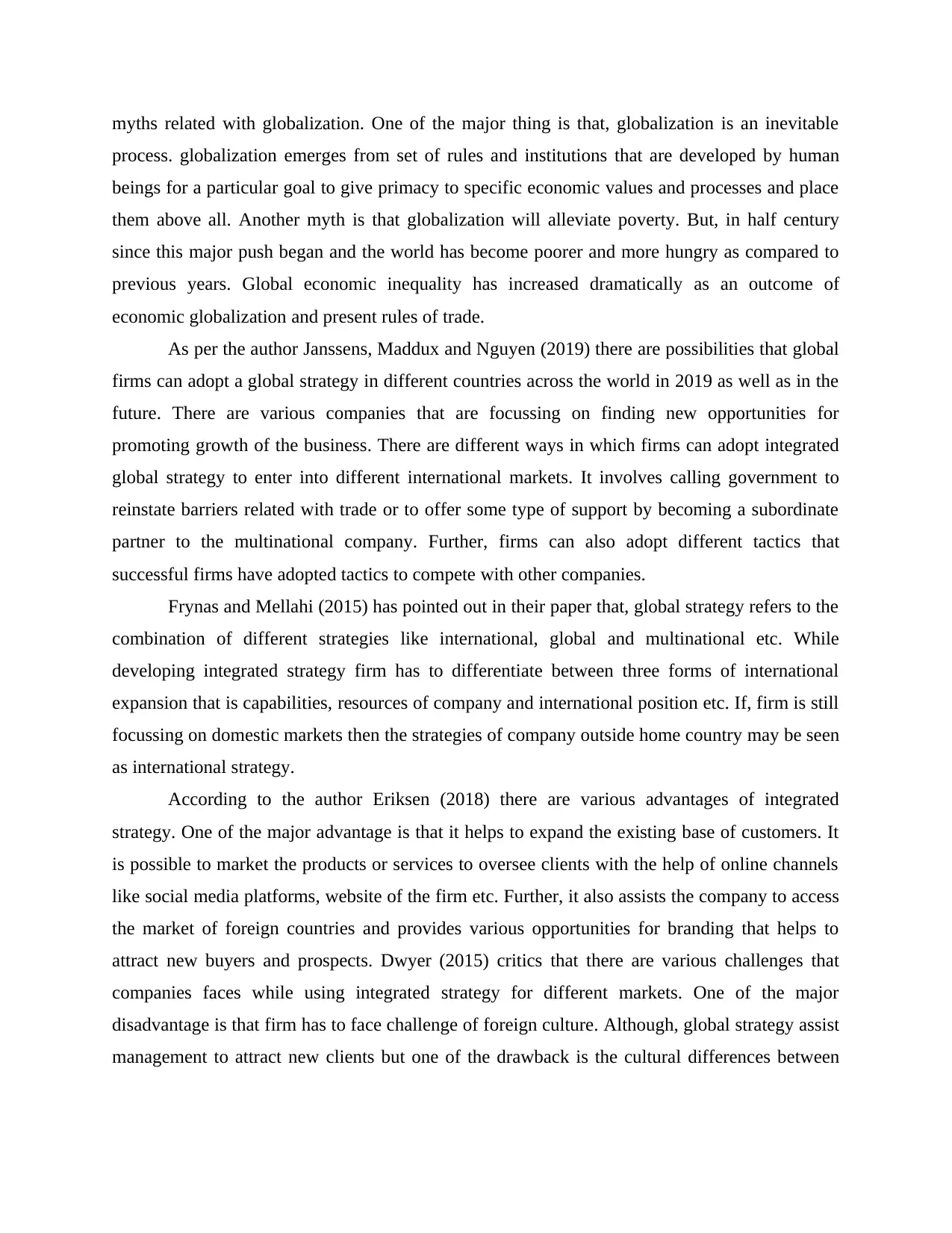
myths related with globalization. One of the major thing is that, globalization is an inevitable
process. globalization emerges from set of rules and institutions that are developed by human
beings for a particular goal to give primacy to specific economic values and processes and place
them above all. Another myth is that globalization will alleviate poverty. But, in half century
since this major push began and the world has become poorer and more hungry as compared to
previous years. Global economic inequality has increased dramatically as an outcome of
economic globalization and present rules of trade.
As per the author Janssens, Maddux and Nguyen (2019) there are possibilities that global
firms can adopt a global strategy in different countries across the world in 2019 as well as in the
future. There are various companies that are focussing on finding new opportunities for
promoting growth of the business. There are different ways in which firms can adopt integrated
global strategy to enter into different international markets. It involves calling government to
reinstate barriers related with trade or to offer some type of support by becoming a subordinate
partner to the multinational company. Further, firms can also adopt different tactics that
successful firms have adopted tactics to compete with other companies.
Frynas and Mellahi (2015) has pointed out in their paper that, global strategy refers to the
combination of different strategies like international, global and multinational etc. While
developing integrated strategy firm has to differentiate between three forms of international
expansion that is capabilities, resources of company and international position etc. If, firm is still
focussing on domestic markets then the strategies of company outside home country may be seen
as international strategy.
According to the author Eriksen (2018) there are various advantages of integrated
strategy. One of the major advantage is that it helps to expand the existing base of customers. It
is possible to market the products or services to oversee clients with the help of online channels
like social media platforms, website of the firm etc. Further, it also assists the company to access
the market of foreign countries and provides various opportunities for branding that helps to
attract new buyers and prospects. Dwyer (2015) critics that there are various challenges that
companies faces while using integrated strategy for different markets. One of the major
disadvantage is that firm has to face challenge of foreign culture. Although, global strategy assist
management to attract new clients but one of the drawback is the cultural differences between
process. globalization emerges from set of rules and institutions that are developed by human
beings for a particular goal to give primacy to specific economic values and processes and place
them above all. Another myth is that globalization will alleviate poverty. But, in half century
since this major push began and the world has become poorer and more hungry as compared to
previous years. Global economic inequality has increased dramatically as an outcome of
economic globalization and present rules of trade.
As per the author Janssens, Maddux and Nguyen (2019) there are possibilities that global
firms can adopt a global strategy in different countries across the world in 2019 as well as in the
future. There are various companies that are focussing on finding new opportunities for
promoting growth of the business. There are different ways in which firms can adopt integrated
global strategy to enter into different international markets. It involves calling government to
reinstate barriers related with trade or to offer some type of support by becoming a subordinate
partner to the multinational company. Further, firms can also adopt different tactics that
successful firms have adopted tactics to compete with other companies.
Frynas and Mellahi (2015) has pointed out in their paper that, global strategy refers to the
combination of different strategies like international, global and multinational etc. While
developing integrated strategy firm has to differentiate between three forms of international
expansion that is capabilities, resources of company and international position etc. If, firm is still
focussing on domestic markets then the strategies of company outside home country may be seen
as international strategy.
According to the author Eriksen (2018) there are various advantages of integrated
strategy. One of the major advantage is that it helps to expand the existing base of customers. It
is possible to market the products or services to oversee clients with the help of online channels
like social media platforms, website of the firm etc. Further, it also assists the company to access
the market of foreign countries and provides various opportunities for branding that helps to
attract new buyers and prospects. Dwyer (2015) critics that there are various challenges that
companies faces while using integrated strategy for different markets. One of the major
disadvantage is that firm has to face challenge of foreign culture. Although, global strategy assist
management to attract new clients but one of the drawback is the cultural differences between
⊘ This is a preview!⊘
Do you want full access?
Subscribe today to unlock all pages.

Trusted by 1+ million students worldwide
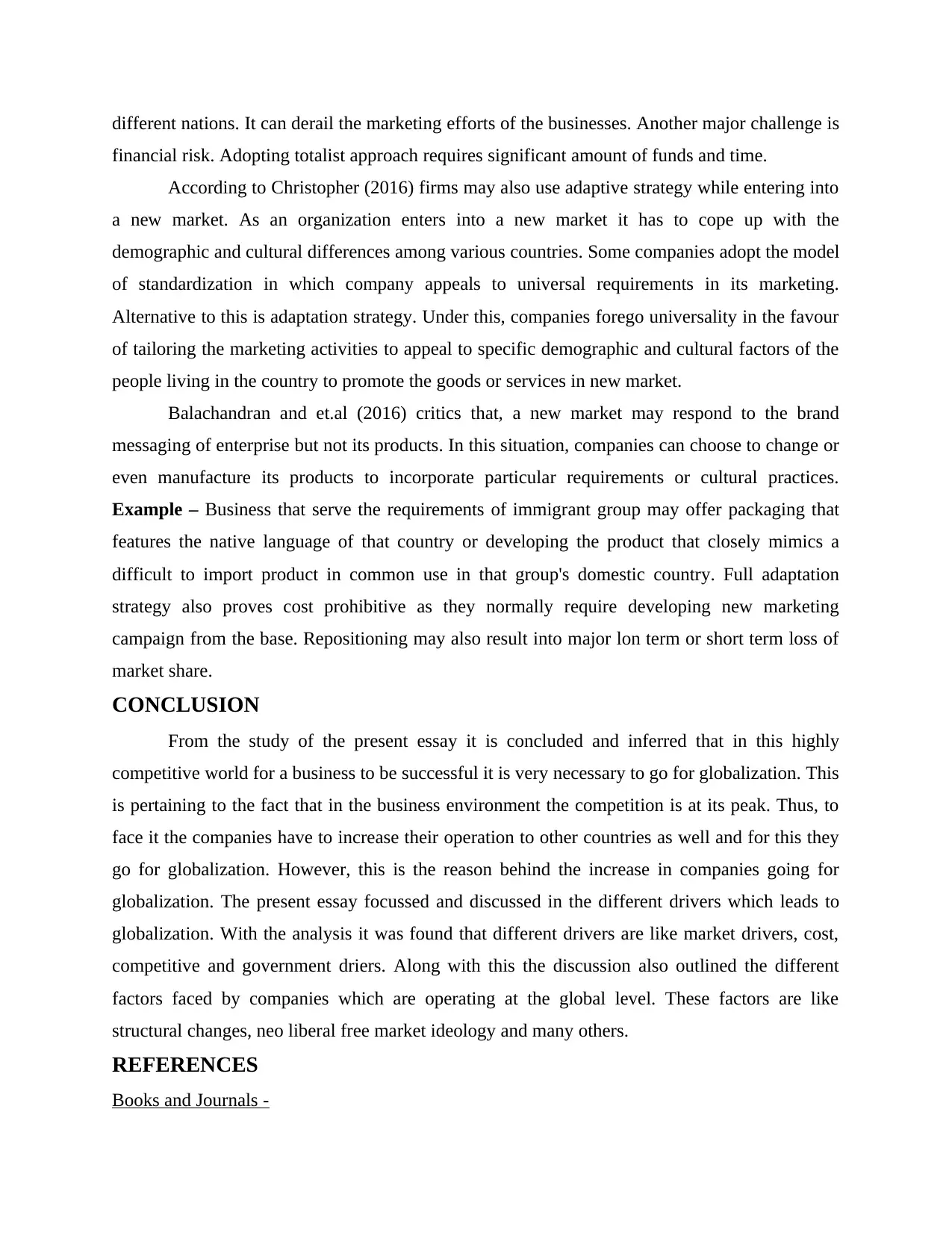
different nations. It can derail the marketing efforts of the businesses. Another major challenge is
financial risk. Adopting totalist approach requires significant amount of funds and time.
According to Christopher (2016) firms may also use adaptive strategy while entering into
a new market. As an organization enters into a new market it has to cope up with the
demographic and cultural differences among various countries. Some companies adopt the model
of standardization in which company appeals to universal requirements in its marketing.
Alternative to this is adaptation strategy. Under this, companies forego universality in the favour
of tailoring the marketing activities to appeal to specific demographic and cultural factors of the
people living in the country to promote the goods or services in new market.
Balachandran and et.al (2016) critics that, a new market may respond to the brand
messaging of enterprise but not its products. In this situation, companies can choose to change or
even manufacture its products to incorporate particular requirements or cultural practices.
Example – Business that serve the requirements of immigrant group may offer packaging that
features the native language of that country or developing the product that closely mimics a
difficult to import product in common use in that group's domestic country. Full adaptation
strategy also proves cost prohibitive as they normally require developing new marketing
campaign from the base. Repositioning may also result into major lon term or short term loss of
market share.
CONCLUSION
From the study of the present essay it is concluded and inferred that in this highly
competitive world for a business to be successful it is very necessary to go for globalization. This
is pertaining to the fact that in the business environment the competition is at its peak. Thus, to
face it the companies have to increase their operation to other countries as well and for this they
go for globalization. However, this is the reason behind the increase in companies going for
globalization. The present essay focussed and discussed in the different drivers which leads to
globalization. With the analysis it was found that different drivers are like market drivers, cost,
competitive and government driers. Along with this the discussion also outlined the different
factors faced by companies which are operating at the global level. These factors are like
structural changes, neo liberal free market ideology and many others.
REFERENCES
Books and Journals -
financial risk. Adopting totalist approach requires significant amount of funds and time.
According to Christopher (2016) firms may also use adaptive strategy while entering into
a new market. As an organization enters into a new market it has to cope up with the
demographic and cultural differences among various countries. Some companies adopt the model
of standardization in which company appeals to universal requirements in its marketing.
Alternative to this is adaptation strategy. Under this, companies forego universality in the favour
of tailoring the marketing activities to appeal to specific demographic and cultural factors of the
people living in the country to promote the goods or services in new market.
Balachandran and et.al (2016) critics that, a new market may respond to the brand
messaging of enterprise but not its products. In this situation, companies can choose to change or
even manufacture its products to incorporate particular requirements or cultural practices.
Example – Business that serve the requirements of immigrant group may offer packaging that
features the native language of that country or developing the product that closely mimics a
difficult to import product in common use in that group's domestic country. Full adaptation
strategy also proves cost prohibitive as they normally require developing new marketing
campaign from the base. Repositioning may also result into major lon term or short term loss of
market share.
CONCLUSION
From the study of the present essay it is concluded and inferred that in this highly
competitive world for a business to be successful it is very necessary to go for globalization. This
is pertaining to the fact that in the business environment the competition is at its peak. Thus, to
face it the companies have to increase their operation to other countries as well and for this they
go for globalization. However, this is the reason behind the increase in companies going for
globalization. The present essay focussed and discussed in the different drivers which leads to
globalization. With the analysis it was found that different drivers are like market drivers, cost,
competitive and government driers. Along with this the discussion also outlined the different
factors faced by companies which are operating at the global level. These factors are like
structural changes, neo liberal free market ideology and many others.
REFERENCES
Books and Journals -
Paraphrase This Document
Need a fresh take? Get an instant paraphrase of this document with our AI Paraphraser
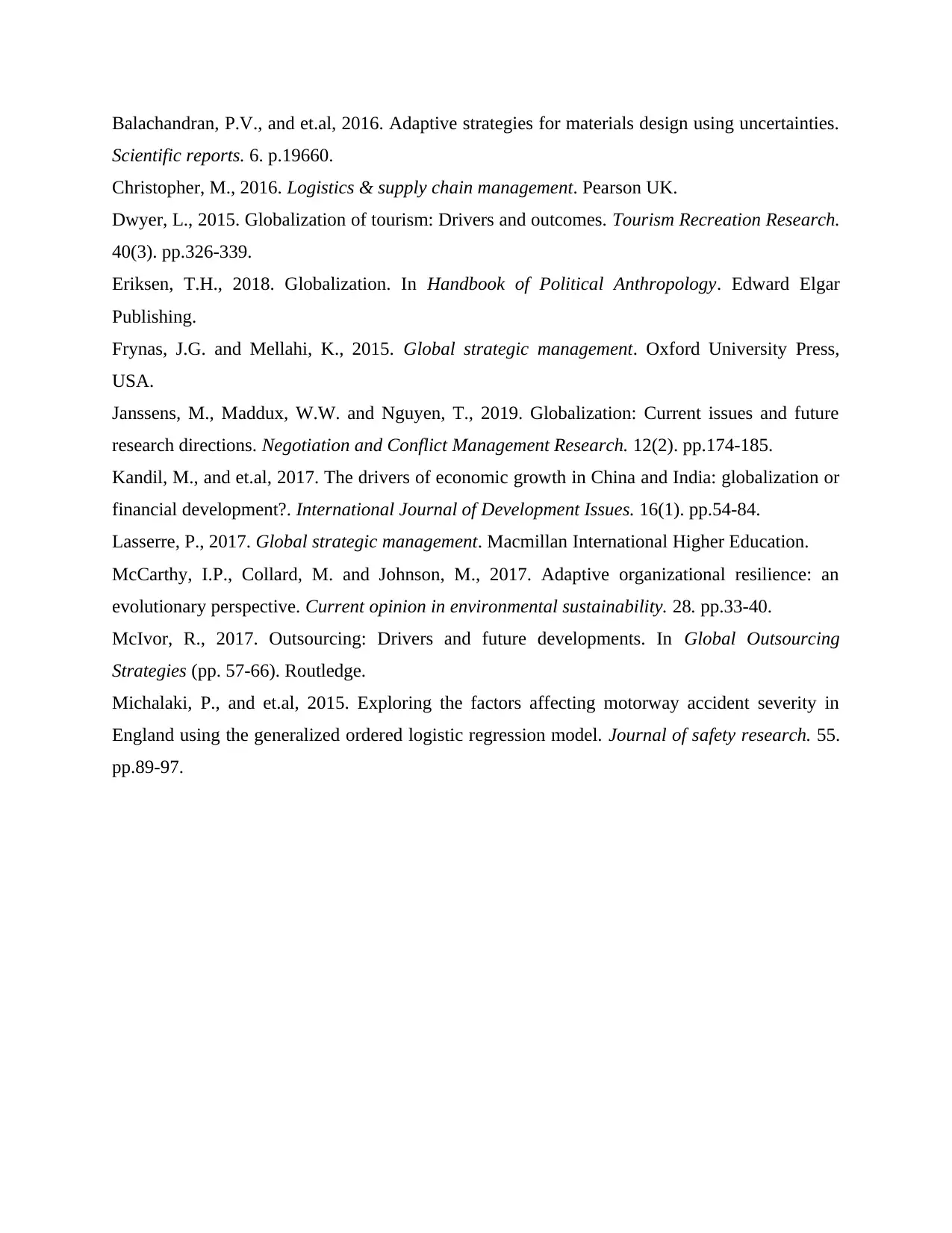
Balachandran, P.V., and et.al, 2016. Adaptive strategies for materials design using uncertainties.
Scientific reports. 6. p.19660.
Christopher, M., 2016. Logistics & supply chain management. Pearson UK.
Dwyer, L., 2015. Globalization of tourism: Drivers and outcomes. Tourism Recreation Research.
40(3). pp.326-339.
Eriksen, T.H., 2018. Globalization. In Handbook of Political Anthropology. Edward Elgar
Publishing.
Frynas, J.G. and Mellahi, K., 2015. Global strategic management. Oxford University Press,
USA.
Janssens, M., Maddux, W.W. and Nguyen, T., 2019. Globalization: Current issues and future
research directions. Negotiation and Conflict Management Research. 12(2). pp.174-185.
Kandil, M., and et.al, 2017. The drivers of economic growth in China and India: globalization or
financial development?. International Journal of Development Issues. 16(1). pp.54-84.
Lasserre, P., 2017. Global strategic management. Macmillan International Higher Education.
McCarthy, I.P., Collard, M. and Johnson, M., 2017. Adaptive organizational resilience: an
evolutionary perspective. Current opinion in environmental sustainability. 28. pp.33-40.
McIvor, R., 2017. Outsourcing: Drivers and future developments. In Global Outsourcing
Strategies (pp. 57-66). Routledge.
Michalaki, P., and et.al, 2015. Exploring the factors affecting motorway accident severity in
England using the generalized ordered logistic regression model. Journal of safety research. 55.
pp.89-97.
Scientific reports. 6. p.19660.
Christopher, M., 2016. Logistics & supply chain management. Pearson UK.
Dwyer, L., 2015. Globalization of tourism: Drivers and outcomes. Tourism Recreation Research.
40(3). pp.326-339.
Eriksen, T.H., 2018. Globalization. In Handbook of Political Anthropology. Edward Elgar
Publishing.
Frynas, J.G. and Mellahi, K., 2015. Global strategic management. Oxford University Press,
USA.
Janssens, M., Maddux, W.W. and Nguyen, T., 2019. Globalization: Current issues and future
research directions. Negotiation and Conflict Management Research. 12(2). pp.174-185.
Kandil, M., and et.al, 2017. The drivers of economic growth in China and India: globalization or
financial development?. International Journal of Development Issues. 16(1). pp.54-84.
Lasserre, P., 2017. Global strategic management. Macmillan International Higher Education.
McCarthy, I.P., Collard, M. and Johnson, M., 2017. Adaptive organizational resilience: an
evolutionary perspective. Current opinion in environmental sustainability. 28. pp.33-40.
McIvor, R., 2017. Outsourcing: Drivers and future developments. In Global Outsourcing
Strategies (pp. 57-66). Routledge.
Michalaki, P., and et.al, 2015. Exploring the factors affecting motorway accident severity in
England using the generalized ordered logistic regression model. Journal of safety research. 55.
pp.89-97.
1 out of 8
Related Documents
Your All-in-One AI-Powered Toolkit for Academic Success.
+13062052269
info@desklib.com
Available 24*7 on WhatsApp / Email
![[object Object]](/_next/static/media/star-bottom.7253800d.svg)
Unlock your academic potential
Copyright © 2020–2025 A2Z Services. All Rights Reserved. Developed and managed by ZUCOL.




